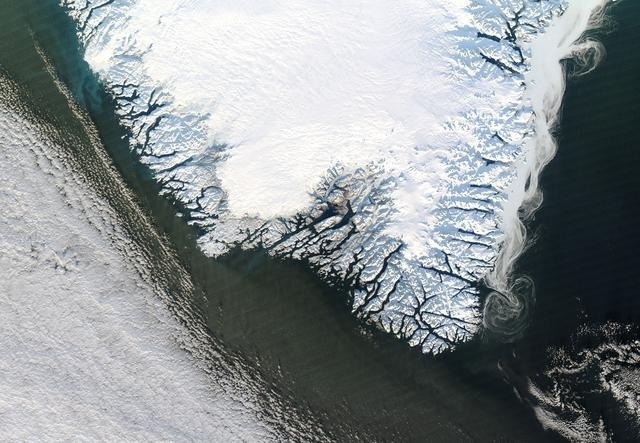In the Arctic, the Greenland Ice Sheet encapsulates 1.7 million km2 (660,200 square miles). If the ice sheet completely melts, the global sea level will increase by around 7 m (23 feet), but experts are unsure how rapidly the ice sheet will melt.
 Much of the southern Greenland Ice Sheet, shown here, will melt irreversibly if we emit about 1000 gigatons of carbon, according to models in a new Geophysical Research Letters study. Image Credit: NASA GSFC.
Much of the southern Greenland Ice Sheet, shown here, will melt irreversibly if we emit about 1000 gigatons of carbon, according to models in a new Geophysical Research Letters study. Image Credit: NASA GSFC.
Modeling tipping points, or key thresholds at which a system’s behavior inevitably alters, assists researchers in determining when that melt might happen.
New research employing simulations recognized two tipping points for the Greenland Ice Sheet: releasing 1000 gigatons of carbon into the atmosphere will induce the southern portion of the ice sheet to melt; releasing about 2500 gigatons of carbon signifies permanent loss of almost the whole ice sheet.
Halfway to the first tipping point is already attained with 500 gigatons of carbon emitted.
The first tipping point is not far from today’s climate conditions, so we’re in danger of crossing it. Once we start sliding, we will fall off this cliff and cannot climb back up.
Dennis Höning, Climate Scientist, Potsdam Institute for Climate Impact Research
Dennis Höning headed the research.
The research was published in Geophysical Research Letters, an AGU publication that promotes short-format, high-impact research in Earth and space sciences.
The Greenland Ice Sheet has already been melting; between 2003 and 2016, it lost roughly 255 gigatons (billions of tons) of ice each year. So far, most of the melt has occurred in the southern part of the ice sheet. Air and water temperature, ocean currents, precipitation, and other factors all influence how quickly and where the ice sheet melts.
The complexities of how those components interact, combined with the long timescales researchers must consider when melting an ice sheet of this magnitude, make it difficult to forecast how the ice sheet would respond to various climate and carbon emissions scenarios.
Earlier studies suggested 1 to 3 ºC (1.8 to 5.4 ºF) global warming as the threshold beyond which the Greenland Ice Sheet may melt irrevocably.
Höning’s new research used a complicated model of the entire Earth system, which includes all of the important climate feedback processes, linked with an ice sheet behavior model for the first time to more completely analyze how the ice sheet’s reaction to climate could evolve over time.
They began by simulating the ice sheet at constant temperatures to discover equilibrium states or locations where ice loss equaled ice gain. The researchers then ran a series of 20,000-year simulations with carbon emissions ranging from 0 to 4000 gigatons.
The investigators calculated the 1000-gigaton carbon tipping point for the melting of the southern portion of the ice sheet and the even more alarming 2,500-gigaton carbon tipping threshold for the disappearance of practically the whole ice sheet from those models.
As the ice sheet melts, its surface will become lower and lower, exposing it to warmer air temperatures. Warmer air temperatures expedite melt, causing it to drop and warm further. For this feedback loop to be productive, global air temperatures must remain raised for hundreds of years or longer; a brief blip of 2 ºC (3.6 ºF) would not trigger it, according to Höning.
However, once the ice passes through the barrier, it will certainly continue to melt. Even if atmospheric CO2 levels were decreased to pre-industrial levels, the ice sheet would not be able to rebuild significantly.
We cannot continue carbon emissions at the same rate for much longer without risking crossing the tipping points. Most of the ice sheet melting won’t occur in the next decade, but it won’t be too long before we will not be able to work against it anymore.
Dennis Höning, Climate Scientist, Potsdam Institute for Climate Impact Research
Journal Reference:
Höning, D., et al. (2023). Multistability and Transient Response of the Greenland Ice Sheet to Anthropogenic CO2 Emissions. Geophysical Research Letters. doi.org/10.1029/2022gl101827.